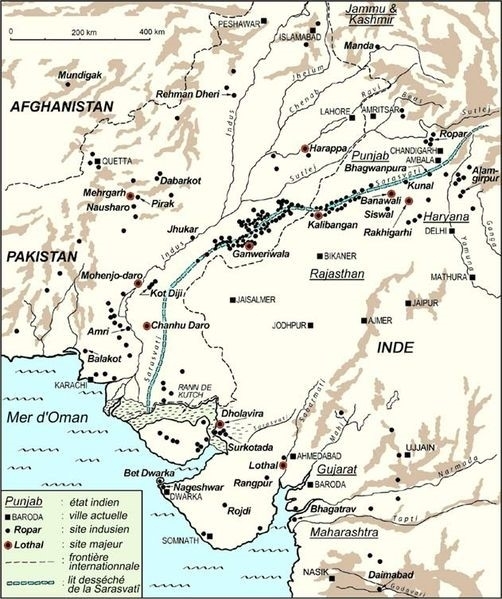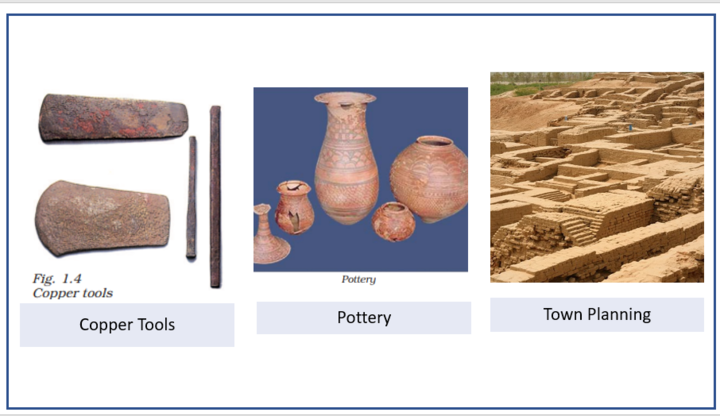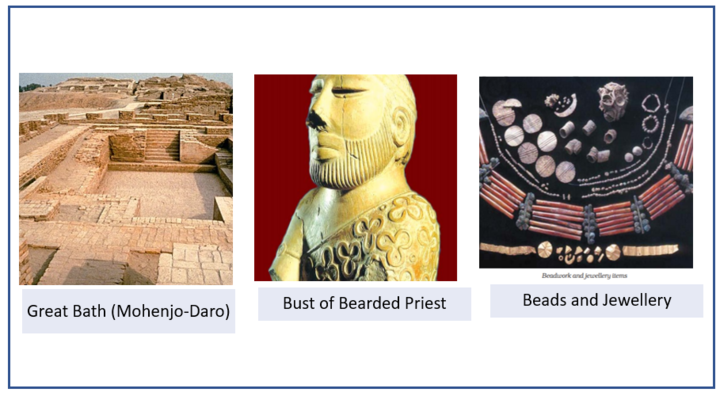- Home/
- SSC & Railways/
- SSC CGL/
- Article
Indus Valley Civilization for SSC: History, Discovery, Religion, Sites & IVC PDF
By BYJU'S Exam Prep
Updated on: September 25th, 2023

Indus Valley Civilization is one of the most frequently asked topics from the general knowledge section and holds significant importance in competitive exams, including SSC Exams. Atleast 3-4 questions are asked from IVC or Harappan civilization in every government exam. In this article, we have discussed Indus valley civilization for SSC in detail to ensure that you won’t lose even one mark from this section.
Indus Valley Civilization, also known as Harappan civilization, is the oldest civilization which flourished between 2500 BC-1750 BC. There are three phases of this civilization. Scroll through the post to find Indus Civilization notes for SSC CGL/CHSL/MTS/GD/CPO exams. Also, download the Indus valley civilization PDF and solve the questions to check your preparation levels and areas that you are lagging in.
Table of content
-
1.
Who Discovered Indus Valley Civilization?
-
2.
What is Indus Valley Civilization?
-
3.
Indus Valley Civilization Map
-
4.
Sites of Indus Valley Civilization
-
5.
Chronology of Indus Valley Civilization
-
6.
Important Indus Valley Civilization Notes
-
7.
Indus Valley Civilisation Decline
-
8.
Indus Valley Civilization SSC Exam Questions
-
9.
Indus Valley Civilization PDF
-
10.
Indus Valley Civilization Quiz
Who Discovered Indus Valley Civilization?
Sir John Hubert Marshall discovered the Indus Valley Civilization in 1921–22. He was the first scholar to use the term “Indus valley civilization” and the fact that it flourished between 2500 BC-1750 BC. Later, Harappan ruins were discovered by Rai Bahadur Daya Ram Sahni and Madho Sarup Vats.
What is Indus Valley Civilization?
Indus Valley Civilization, also known as Harappan Civilization, is a Bronze age civilization that existed through its early years of 3300-1300 BCE, and its mature period of 2600-1900 BCE. The area of this civilization was spread along the Indus River from what today is northeast Afghanistan into Pakistan and northwest India.
Indus Valley Civilization Map
Extent: Jammu in the North till Narmada Estuary in the south. Makran coast in the west till Meerut in the East.

Image source: NCERT
Sites of Indus Valley Civilization
Some of the pointers on the Indus Valley Civilization related to the important cities and their archaeological importance were found helpful in finding important details and establishing the facts. In addition to that information related to the person who discovered the evidence. Aspirants must revise this table for the SSC exams.
|
Indus Valley Civilization City |
River |
Indus Valley Civilization Discovery |
Archaeological Importance |
|
Harappa |
Ravi |
Daya Ram Sahni (1921) |
|
|
Mohenjodaro |
Indus |
Rakhal Das Benerjee (1922) |
|
|
Lothal |
Bhogava |
S. Rangaath Rao (1954) |
|
|
Chanhudaro |
Indus |
N Gopal Majumdar (1931) |
|
|
Dholavira |
Luni |
J.P. Joshi (1967-68) |
|
Chronology of Indus Valley Civilization
The three periods of the Indus Valley Civilization—the Early Harappan Phase, which lasted from 3300 to 2600 BCE, the Mature Harappan Phase, which lasted from 2600 to 1900 BCE, and the Late Harappan Phase, which lasted from 1900 to 1300 BCE—are frequently distinguished.
- Period 1: Pre-Harappan Period (3300 BC – c. 2800 BC)
- Period 2: Early Harappa Period (c. 2800 BC – c. 2600 BC)
- Period 3: Harappa Period
- Period 3A Harappan Phase A (c. 2600 BC – c. 2450 BC)
- Period 3B Harappa Phase B (c. 2450 BC – c. 2200 BC)
- Period 3C Harappa Phase C (c. 2200 BC – c. 1900 BC)
- Period 4: Harappa/Late Harappa Transitional Period (c. 1900 BC – c. 1800 BC)
- Period 5: Late Harappa Phase (c. 1800 BC – < 1300 BC)
Important Indus Valley Civilization Notes
Every competitive exam comprises questions on the Indus Valley Civilization which makes it one of the most important topic that candidates cannot miss.
Town Planning of Indus Valley Civilization
Small Early Harappan villages had grown into sizable urban centres by 2600 BCE. These cities are Dholavira, Kalibangan, Rakhigarhi, Rupar, and Lothal in contemporary India, and Harappa, Ganeriwala, and Mohenjodaro in contemporary Pakistan. Over 1,052 towns and communities have been discovered in total, mostly around the Indus River and its tributaries.
- Grid system(Chess-board) of town planning
- Rectangular houses with brick-lined bathrooms and wells together with stairways are found
- Use of Burnt bricks
- Underground drainage system
- Fortified citadel
Agriculture of Indus Valley Civilization
- Sindon – Cotton – Major trade good – earliest people to produce Cotton.
- Proofs of Rice husk found
- Wheat and Barley were majorly cultivated
- Use of wooden ploughshare. They had no idea about Iron implements.
Domestication of Animals
- Oxen, Buffalo, Goats, Sheep, and Pigs were domesticated
- Asses and camels were used as Beasts of Burden
- Elephants and Rhino were known
- Remains of horses found in Surkotada and evidence of horses in Mohenjodaro and Lothal are also found. But the civilization was not horse-centred.

Technology and Crafts
- Bronze (Copper + tin) tools were widely used.
- Stone implements were still in vogue.
- Potter’s wheel was put to full use.
- Bronzesmiths, Goldsmiths, Boat-Making, Brick-laying etc were other occupations commonly found.
Trade of Indus Valley Civilization
- The presence of granaries, weights and measures, seals and uniform script signifies the importance of trade.
- The barter system was widely prevalent.
- Lothal and Sutkagendor were port cities used for conducting trade.
- Trade destinations – Afghanistan, Iran and Central Asia. Contacts with Mesopotamia civilization are also seen.
Political Organization of Indus Valley Civilization
- Cultural homogeneity is achieved through a strong central authority.
- No temples or religious structures were found. Harappa was possibly ruled by the merchant class.
- Weapons are rarely found.
Indus Valley Civilization Religion
The religion of Harappa is still up for debate. There is widespread speculation that the Harappans revered a mother deity who represented fertility. The Indus Valley Civilization does not appear to have had any temples or palaces that would have provided obvious proof of religious practices or individual deities, in contrast to Egyptian and Mesopotamian civilizations. A swastika sign, used in later Indian faiths including Hinduism, Buddhism, and Jainism, is shown on a few Indus Valley seals.
- Terracotta figure of Mother Goddess.
- Phallu and Yoni worship.
- Pashupati Mahadev seal was found with the elephant, tiger, rhino and a bull surrounding him with two deer near his feet.
Tree and Animal Worship of Indus Valley Civilization
- Pipal tree worship was found.
- One-horned Unicorn recognized as Rhino and the humped bull was commonly worshipped.
- Use of Amulets to ward off ghosts and evil spirits.
- The lion was not known in Harappan culture.
The Harappan Script
- The Harappan script is Pictographic in nature but has not been deciphered so far.
- They are recorded on seals and contain only a few words
- Harappan Script is the oldest script in Indian Sub-continent
Weights and Measures of Indus Valley Civilization
- Use of standardized weights and measures to keep accounts of private property, to indulge in trade and commerce etc.
- Weights are found in multiples of 16.
Harappan Pottery of Indus Valley Civilization
- Well-developed Pottery techniques with elaborate designs of trees and circles.
- Redware pottery painted with black designs.

Check Out: Learn and Revise Polity Through Mind Maps
Indus Valley Civilisation Seals
- Seals were used for the purpose of trade or worship. Images of animals such as Buffalo, bull, tiger etc were found inscribed in the seals
Sculptures of Indus Valley Civilisation
- The most important sculpture of the Indus Valley Civilization is the Dancing Girl.
- Besides it, sculptures like Bronze statue of a naked woman, Mother Goddess, bearded man steatite statue and Male Torso were discovered.
Terracotta figurines of Indus Valley Civilisation
- Terracotta – Fire-baked earthen clay
- Used as toys or objects of worship
- Massive stone works were not found in Harappa which shows the poorly developed artistic works made of stone
Indus Valley Civilisation Decline
Around 1800 BCE, climate change and migration caused the Indus Valley Civilization to fall. Mohenjo-Daro and Harappa, the two major cities of the Civilization, finally vanished. Because it was the earliest city of the civilisation that contemporary archaeologists found, Harappa gives the Indus Valley people their name.
Archaeological data suggests that commerce with Mesopotamia, which is mostly located in present-day Iraq, seems to have ceased. The large cities’ sophisticated drainage systems and baths were covered up or stopped. Standardized weights and measurements that were used for commerce and taxes started to vanish, along with writing.
Causes for Indus Valley Civilisation Decline
Following reasons are considered to be responsible for the decline of Indus Valley Civilization:
- Decreasing fertility due to increasing salinity on the account of the expansion of the nearby desert.
- Sudden subsidence of uplift of land causing floods.
- Earthquakes caused changes in the course of Indus.
- The harappan culture was destroyed by invading Aryans.
Post-urban Phase (1900BC – 1200BC)
- Sub-Indus Culture
- Primarily chalcolithic
- Development of Ahar Culture, Malwa Culture and Jorwe Culture at various phases in post-Harappan Civilization.
Indus Valley Civilization SSC Exam Questions
In the SSC exam, the difficulty level of the Indus valley civilization questions is usually of easy-moderate level. Questions are asked based on the evidence, rivers, agriculture pattern and lifestyle. Take a look at the sample questions on Indus valley civilization asked in SSC CGL previous year papers & SSC CHSL previous year papers.
Q2. The local name of Mohenjodaro is:
Indus Valley Civilization PDF
The Indus Valley Civilization is one of the most important and vast topics of SSC General Knowledge. Thus, it will be better for you to download the PDF to prepare it whenever you want. Below, we have provided the direct link to download the Indus Valley Civilization PDF for SSC Exams.
> Download Indus Valley Civilization PDF
Indus Valley Civilization Quiz
Now that you have learnt all the important details on the Indus valley civilization, to check your knowledge attempt the Indus valley civilization quiz for SSC given below.
> Attempt Quiz on Indus Valley Civilization
Since now you have got all the study material to prepare for Indus Valley Civilization for SSC, you must kickstart your preparation without any deferral!
We hope this was useful to you.
Happy Learning
3 Crore+ Registered Aspirants | 2.5 Crore Downloads | 50,000+ Selections
 Get SSC Exams Important Updates, Study Notes, Free PDF & more, Join BYJU’S Exam Prep SSC Telegram Group Join Now
Get SSC Exams Important Updates, Study Notes, Free PDF & more, Join BYJU’S Exam Prep SSC Telegram Group Join Now 

